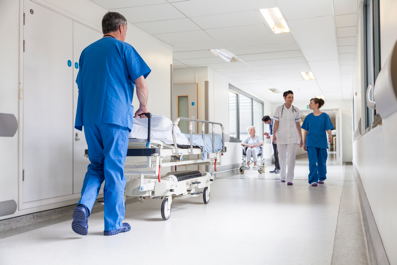Locks and Security News: your weekly locks and security industry newsletter
24th July 2024 Issue no. 715
Your industry news - first
We strongly recommend viewing Locks and Security News full size in your web browser. Click our masthead above to visit our website version.
Finding the Key to Efficiency in Healthcare
 The physical environment of a healthcare facility is the foundation of all that occurs in it. Implementing effective safety and security solutions creates an environment that enhances the building for those working and staying in such facilities.TRIMTO]
The physical environment of a healthcare facility is the foundation of all that occurs in it. Implementing effective safety and security solutions creates an environment that enhances the building for those working and staying in such facilities.TRIMTO]
With the ever-changing landscape that is the healthcare provision, it's important to opt for solutions that provide the cornerstones for success and progression, rather than act as sources of limitation. Healthcare facilities present a considerably complex security challenge.[
Optimising a facility's physical environment - that is, everything from door hardware to locks and access control - has a direct link to improved patient health and safety, staff safety, security and performance, in turn, increasing operational efficiencies and financial outcomes.
There are multiple influencing factors to choosing the right solutions, such as reducing noise, maximising free passage for optimum people movement, minimising cross-contamination, administering adequate preparation for emergency situations and allowing safe and efficient egress when necessary.
Years ago, older healthcare buildings with outdated or damaged hardware were limited by choice, and the upgrades that were available weren't always an appropriately fitted replacement. Notwithstanding this, any budgeting pressures these facilities faced led to a reluctance to upgrade old traditional systems.
Today, however, the scope of solutions available to the UK market means that healthcare facilities, such as hospital buildings, can opt for solutions that fit their specific needs and requirements, aligning with their values and targets along the way.
Safety and satisfaction
A recent report by the Care Quality Commission (CQC) has revealed that almost a third of private hospitals in England are failing on patient safety.
Professor Ted Baker, chief inspector of hospitals at the CQC, said that a part of this was because of a lack of formal governance protocols. This includes "a lack of safety checks and poor monitoring of risks," where safety has neglected to be viewed as a corporate responsibility.
In reality, the safety of patients - and staff, for that matter - expands further than just day-to-day internal procedures.
The Regulatory Reform (Fire Safety) Order 2005 enforced the responsibility that facility managers and business owners have in remaining fire safety compliant.
Fire doors, in particular, need to be given meticulous attention to ensure compliance. The slightest damage could render a fire door inadequate, putting lives at risk in the event of a fire.
Regular checks, such as fire door operation and up-to-date risk assessments, are crucial to maximising patient and staff satisfaction, maintaining legislation compliance and, ultimately, keeping everyone on the premises safe.
Efficient access and egress
In situations that require high levels of egress, such as during busier periods and in emergency situations like an evacutation, it is essential hospitals are equipped with doors and door hardware which accommodate these needs.
Methodical solutions such as cross-corridor openings support this range of requirements, aiding egress whilst also resisting damage, operating quietly and aiding wheelchair access.
When hospital staff need to carry medical supplies, push gurneys or carts, or move quickly, doors and door hardware must allow smooth access into and from a room whilst also providing privacy and safety for a patient.
On top of this, doors should be fitted with easy-open features. For example, support staff should have their hands free to aid the young, the elderly and those with disabilities who need assistance. Electromagnetic and cam-action door closers are ideal for high-use internal areas that require doors to be held open, swing-free or have lighter operational forces, making them the perfect solution for hospitals and care homes.
As healthcare staff levels are showing a slight decrease in recent reports, it's important for door hardware to assist the challenges staff may face rather than limit day-to-day running.
Access control for sensitive areas
Certain areas within healthcare facilities are high security such as pharmacies, patient records and medical supplies, which require a higher level of security and restricted access. These sensitive areas in the facility require records of when and by whom the area was accessed. They also need to stop unauthorised access to these areas. With the help of networked access control with real-time management and monitoring, all sensitive areas can be made secure for both patients and staff.
Infection control
Bacteria-resistance is a beneficial operational feature in preventing the spread of germs that contribute to hospital-acquired infections.
Around 80 percent of infections are transmitted through our environment, from the air we breathe to the surfaces we touch.
Being one of the most common harbourers of bacterium, door handles, grabrails and other contact surfaces can exacerbate cross-contamination, presenting a focal-point that facilitates the transmission of germs throughout a building.
For that extra layer of cleanliness, door hardware with in-built anti-bacterial protection - such as exit devices and lever furniture - helps to battle against the spreading of germs.
Not only is a clean and safe environment a basic standard set by the CQC, it can also improve patient and staff satisfaction, leading to a well-organised and efficient-running healthcare facility overall.
For more, visit www.allegion.co.uk
23rd May 2018








